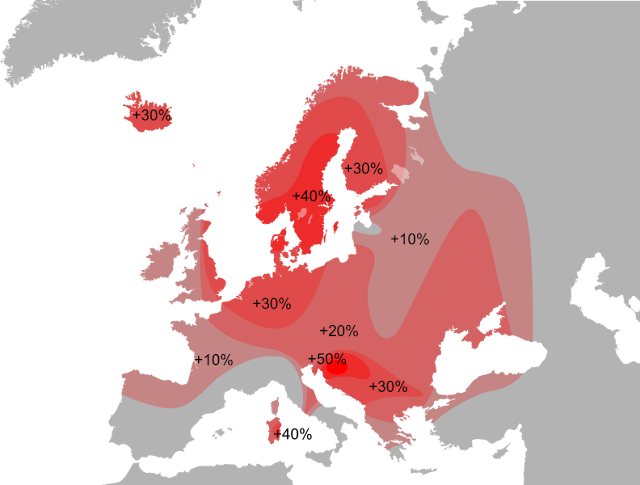In human genetics, an Y-chromosome DNA haplogroup' is a haplogroup defined by differences in the non genetic recombining portions of DNA from the Y chromosome (called Y-DNA).
Y-DNA Haplogroups define the most recent patrilineal (male-lineage) ancestors of all living humans and so they can establish from where a single individual or an entire population come from.
| Y─ DNA Adam |
|
Estimation of the distribution of Y-Dna Haplogroups in Sardinian People:
| I | R1b | G2a | J2 | J1 | E1b1b | T + (L) | Q | |
|---|---|---|---|---|---|---|---|---|
| Sardinia | 45/37% | 25/22% | 15/11% | 10% | 2.5/2% | 10/5% | 1.5/0% | 2% |
 |
| Y-dna haplogroups distribution in Europe |
Haplogroup I Y-DNA
Between 37-45% of Sardinians belong to the I Y-dna Haplogroup, it is today spread almost exclusevely in Europe and it is found in 1/5 of the European Population.
The time of origin of this haplogroup is estimated between 25,000 - 30,000 years BP, placing the Haplogroup I founding event approximately contemporaneous with the Last Glacial Maximum (period in the Earth's climate history when ice sheets were at their maximum extension). It is the most ancient Y-dna haplogroup present in Europe today.
Out Sardinia the Haplogroup I shows high prevalence only in Scandinavia, Northern Germany and the Balkans, in particular in Croatia, Bosnia and Herzegovina, Montenegro and Serbia.
 |
| Haplogroup I |
Haplogroup I has two major subclades, one called I1 that has the highest frequency in the Northern Europe (mainly in Scandinavia) and another one called I2a prevailing in South Europe, in particular in the west balkanic region and in Sardinia.
 |
| Subclade I2a |
Furthermore, the haplogroup I of the indigenous Sardinians is the I2a1 subtype, formerly known as I-M26, which is almost unique to the island, though it has also distribution in other areas of Western Europe, mainly in Iberia, in Particular among the Basques and among people living on the Pyrenees Range, mainly in the Department of Béarn In France. It is found in lower percentages also in Brittany, England, Sweden and Corsica.
The highest frequency of this subclade is found among Sardinians from the most inaccessible and remotest mountainous regions of Barbagia and Ogliastra, in the Central and East part of the island.
The highest frequency of this subclade is found among Sardinians from the most inaccessible and remotest mountainous regions of Barbagia and Ogliastra, in the Central and East part of the island.
 |
| Subclade I2a1 (shown as M26 in the map) |
Haplogroup R1b Y-DNA
The Haplogroup R1b is the most frequently occurring Y-Dna haplogroup in Western Europe, and the second most frequent in Sardinians. Its frequency is between 22-25%, it is more spread among Northern Sardinians, in particular in Gallura (North East Sardinia).











